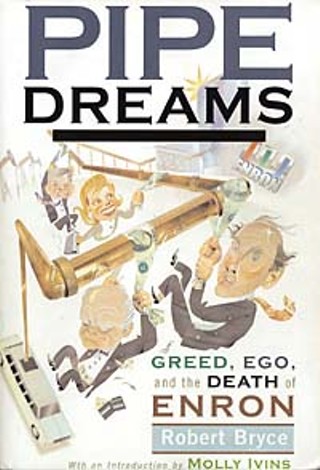Pipe Dreams
George W. to the rescue, part 1
By Robert Bryce, Fri., Oct. 4, 2002

It's a good thing George W. Bush has a laissez-faire approach to business. Otherwise, it might look like he was just trying to help his pals at Enron.
Although the California energy crisis was raging throughout Bush's first few months in the White House in 2001, the president refused -- for nearly six months -- to consider the possibility that the Golden State's power markets were being manipulated. In some parts of the state, electricity rates had gone from $30 per megawatt hour to an alarming $1,500 per megawatt hour. Rolling blackouts -- and threats of blackouts -- had the state in a near-constant uproar. One of the state's biggest utilities, Pacific Gas & Electric, went bankrupt, and another, Southern California Edison, almost did. By the time Bush had spent about 180 days in the White House, the state of California had spent nearly $8 billion buying power on the open market just to keep the lights on.
Despite the crisis, Dianne Feinstein, a U.S. senator from California -- the largest state in the union -- couldn't get an appointment with Bush. Maybe it was because she was a Democrat. Maybe it was because Bush lost California to Al Gore during the election. Whatever the reason, the White House rejected her request for a meeting and even did her the favor of sending back a form letter that misspelled her name.
The White House had plenty of time for Enron, though. On April 17, 2001, Vice-President Cheney had a private meeting with Enron chairman Ken Lay. During the meeting, Lay offered suggestions for Cheney's energy task force and lobbied Cheney against price caps in California. Lay even handed Cheney a memo that said, "The administration should reject any attempt to re-regulate wholesale power markets by adopting price caps." Even temporary price restrictions, the Lay memo said, "will be detrimental to power markets and will discourage private investment."
Cheney quickly adopted Lay's argument. The day after his meeting with Lay, Cheney mocked the idea of price caps. He told the Los Angeles Times that caps would only provide "short-term political relief for the politicians." He also said price restrictions would discourage investment, a matter Cheney called "the basic fundamental problem."
In late May, Bush visited California and, like Cheney, attacked the idea that price caps -- something California Governor Gray Davis and Feinstein had been begging for -- might help the state restore order to its electricity system. "Price caps do nothing to reduce demand, and they do nothing to increase supply," Bush said flatly.
Bush and Cheney were wrong. Enron and several other power companies had apparently been manipulating the California energy market for months and collecting huge revenues for their efforts. Using strategies with colorful names like Death Star, Get Shorty, Fat Boy, and Ricochet, Enron had apparently figured out ways to play the state's power system and drive up prices. Finally, on June 18, 2001, after weeks of rising intrigue, the Federal Energy Regulatory Commission approved limited price caps for California. The move quickly settled the state's power markets.
Of course, Bush didn't just help Enron in California. Bush and Cheney allowed Enron to write part of the administration's energy task force plan for America's national energy policy.
Ken Lay had helped George W. Bush every step of the way during his journey to the White House. Lay had been one of Bush's first "pioneers," each of whom pledged to raise $100,000 for Bush. Lay had made Enron's fleet of airplanes available to the Bush campaign. The Bush campaign used Enron's jets to fly to different events on eight different occasions -- that's more than any other corporation. During the 2000 election cycle, Lay contributed more than $275,000 to the Republican National Committee. Enron's total donations to the party exceeded $1.1 million. Enron gave $250,000 to help fund the Republican Party National Convention in Philadelphia. When the outcome of the election was in doubt after the polls closed in November 2000, Lay and his wife, Linda, gave $10,000 to help finance the Bush campaign's Florida operation during the recount after the election.
After Bush prevailed in the election (thanks to an assist by the U.S. Supreme Court) Ken and Linda Lay gave another $100,000 to help finance Bush's inaugural gala. In all, Enron and its top execs kicked in $300,000 for the inauguration festivities. Naturally enough, the day after the inauguration, Lay went to a private lunch party at the White House, where he got to schmooze with the new president one-on-one. A few weeks later, Lay had dinner with the president. Beyond all that, Enron's connections in the White House went much further than George W. Bush. The new president's chief economic adviser, Larry Lindsey, was on Enron's payroll before going to the White House, earning $100,000 in consulting fees from the Houston company. Marc Racicot, the former governor of Montana, lobbied for Enron before Bush named him to lead the Republican National Committee. Robert Zoellick, Bush's choice for U.S. trade representative, served on an Enron advisory council. Thomas White, Bush's secretary of the army, was the vice-chairman at Enron Energy Services, a money-losing charade of a company. Nevertheless, when White left Enron, he owned more than $25 million in the company's stock. Bush's chief strategist and political guru, Karl Rove, owned more than $100,000 of Enron stock when Bush took office.
With Bush in office and his pals in the White House, Lay was only too happy to provide them with guidance.
Lay recommended a total of 21 people for various federal posts. Three got the spots Lay asked for. But they were critically important jobs to Enron. Lay was particularly interested in the Federal Energy Regulatory Commission, or FERC, because that agency regulates the transmission and sale of natural gas in interstate pipelines and the transmission and wholesaling of electricity on interstate wires -- both of which are key parts of Enron's business. Lay recommended that Bush appoint Pat Wood, the chairman of the Texas Public Utility Commission and a strong proponent of deregulation, to the FERC. Bush did. Lay also recommended Nora Brownell for the FERC. In fact, Lay placed a number of phone calls to Bush's chief political strategist, Karl Rove, to urge the appointment of Brownell. Again, Bush did as Lay asked. Lay asked Bush to appoint Glenn L. McCullough to the chairmanship of the Tennessee Valley Authority, a powerful agency in the Southeast that operates more than two dozen hydroelectric dams and other power plants that had a terrible relationship with Enron due to a dispute over huge electricity contracts Enron did not want to fulfill. Again, Bush did as Lay requested.
Bush's White House provided Lay and Enron with unprecedented access. In addition to the meeting with Lay, Enron officials met with Cheney's task force (the National Energy Policy Development Group) five times and talked with that task force by phone on at least six other occasions about the measure. Their effort shows.
The National Energy Policy Development Group's final report, "Reliable, Affordable and Environmentally Sound Energy for America's Future," released in mid-May of 2001, contains a number of provisions very favorable to Enron. For instance, the report recommends the creation of a national electricity grid, a move that could allow Enron to trade electric power more readily in all regions of the country. The report says permitting for gas pipelines should be expedited, a factor that would help Enron, already one of the largest pipeline companies in the world, build more capacity more quickly. The report says America needs legislation that would create a market-based program for trading of pollution credits. That would allow electric utilities to create a market in which they could trade the amount of pollutants such as sulfur dioxide, nitrogen oxide, and mercury coming out of their power plants. (Trading of pollution credits is touted as a way for market forces to reduce overall pollution levels emitted by industrial plants and energy facilities.) Surely it's just a coincidence that Enron was one of the biggest traders of pollution credits in America. In early 2001, Enron paid the Environmental Protection Agency more than $21 million for a batch of pollution credits in sulfur dioxide. Enron bought 45 times more credits than any other company participating in the auction.
The report talks about the California crisis, the need for energy efficiency, increased domestic natural gas production, and, of course, India. Didn't you know that the cost of butane in Bombay is critical to soccer moms in Seattle? Cheney's group recommended that "the President direct the Secretaries of State and Energy to work with India's Ministry of Petroleum and Natural Gas to help India maximize its domestic oil and gas production."
Not only could Lay get Bush's ear on appointments, he could get federal reports to mention countries like India, where Enron, with the Dabhol electricity and liquefied natural gas project (which is also mentioned in Cheney's report), was a major investor.
To be fair, the energy report discusses world energy prices and the growing importance of America's access to energy-rich areas like the Caspian Sea. It also discusses America's growing reliance on energy from Mexico and Canada. But the State Department, which participated in the writing of the energy report, didn't add the India section, the White House did. Personnel in the State Department who worked on the report said the language about India was inserted into the task force's energy plan after it came under the control of the White House in late March 2001.
Ken Lay's money on George W. Bush had been well spent. ![]()
Pipe Dreams: Greed, Ego and the Death of Enron, by former Chronicle reporter Robert Bryce, is being published this month by PublicAffairs. Chapter 37, "George W. Bush to the Rescue, Part 1" is reprinted with permission by PublicAffairs, a member of the Perseus Books Group. Copyright 2002 by Robert Bryce.
Got something to say on the subject? Send a letter to the editor.








